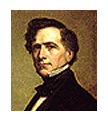
US Presidents (POTUS)
The American President is widely considered to be the most powerful person on the earth, and is usually one of the world's best-known public figures.
 Franklin
Pierce
Franklin
Pierce
14th President of the United States
(March 4, 1853 to March 3, 1857)
Nicknames:
-
"The Fainting General," A sneering reference by political opponents to an incident during a Mexican War battle when an artillery blast blew the saddle off Pierce's horse and drove the saddle-horn hard into his abdomen, causing him to lose consciousness for a few minutes
-
"Young Hickory of the Granite Hills, "Young Hickory" compared his military deeds (in the Mexican-American War) with those of Andrew Jackson. "The Granite Hills" were his home state of New Hampshire
Franklin Pierce
Born: November 23, 1804, in Hillsborough (now Hillsboro),
New Hampshire
Died: October 8, 1869, in Concord, New Hampshire
Father: General Benjamin Pierce
Mother: Ann Kendrick Pierce
Married: Jane Means Appleton (1806-1863), on November 10, 1834
Children: Franklin Pierce (1836); Frank Robert Pierce (1839-43);
Benjamin Pierce (1841-53)
Religion: Episcopalian
Education: Graduated from Bowdoin College (1824)
Occupation: Lawyer, public official
Political Party: Democrat
Other Government Positions:
- Served in New Hampshire Legislature, 1829-33
- Member of US House of Representatives, 1833-37
- Unites States Senate, 1837-42
Franklin Pierce Biography
Franklin Pierce became President at a time of apparent tranquility.
The United States, by virtue of the Compromise of 1850, seemed to have
weathered its sectional storm. By pursuing the recommendations of southern
advisers, Pierce--a New Englander--hoped to prevent still another outbreak
of that storm. But his policies, far from preserving calm, hastened
the disruption of the Union.
Born in Hillsborough, New Hampshire, in 1804, Pierce attended Bowdoin
College. After graduation he studied law, then entered politics. At
24 he was elected to the New Hampshire legislature; two years later
he became its Speaker. During the 1830's he went to Washington, first
as a Representative, then as a Senator.
Pierce, after serving in the Mexican War, was proposed by New Hampshire
friends for the Presidential nomination in 1852. At the Democratic Convention,
the delegates agreed easily enough upon a platform pledging undeviating
support of the Compromise of 1850 and hostility to any efforts to agitate
the slavery question. But they balloted 48 times and eliminated all
the well-known candidates before nominating Pierce, a true "dark horse."
Probably because the Democrats stood more firmly for the Compromise
than the Whigs, and because Whig candidate Gen. Winfield Scott was suspect
in the South, Pierce won with a narrow margin of popular votes.
Two months before he took office, he and his wife saw their eleven-year-old
son killed when their train was wrecked. Grief-stricken, Pierce entered
the Presidency nervously exhausted.
In his Inaugural he proclaimed an era of peace and prosperity at home,
and vigor in relations with other nations. The United States might have
to acquire additional possessions for the sake of its own security,
he pointed out, and would not be deterred by "any timid forebodings
of evil."
Pierce had only to make gestures toward expansion to excite the wrath
of northerners, who accused him of acting as a cat's-paw of Southerners
eager to extend slavery into other areas. Therefore he aroused apprehension
when he pressured Great Britain to relinquish its special interests
along part of the Central American coast, and even more when he tried
to persuade Spain to sell Cuba.
But the most violent renewal of the storm stemmed from the Kansas-Nebraska
Act, which repealed the Missouri Compromise and reopened the question
of slavery in the West. This measure, the handiwork of Senator Stephen
A. Douglas, grew in part out of his desire to promote a railroad from
Chicago to California through Nebraska. Already Secretary of War Jefferson
Davis, advocate of a southern transcontinental route, had persuaded
Pierce to send James Gadsden to Mexico to buy land for a southern railroad.
He purchased the area now comprising southern Arizona and part of southern
New Mexico for $10,000,000.
Douglas's proposal, to organize western territories through which a
railroad might run, caused extreme trouble. Douglas provided in his
bills that the residents of the new territories could decide the slavery
question for themselves. The result was a rush into Kansas, as southerners
and northerners vied for control of the territory. Shooting broke out,
and "bleeding Kansas" became a prelude to the Civil War.
By the end of his administration, Pierce could claim "a peaceful condition
of things in Kansas." But, to his disappointment, the Democrats refused
to renominate him, turning to the less controversial Buchanan. Pierce
returned to New Hampshire, leaving his successor to face the rising
fury of the sectional whirlwind. He died in 1869.
Source: http://www.whitehouse.gov/

US Presidents: Life & Accomplishments



